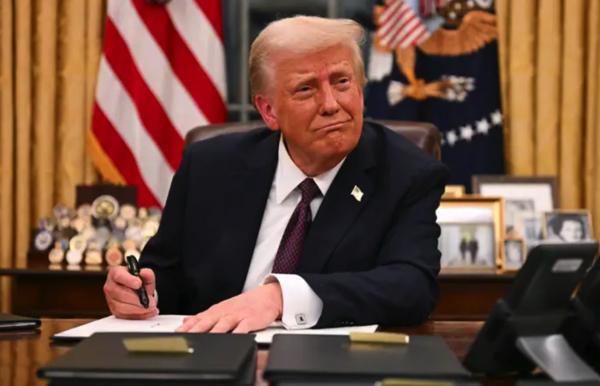 Parler
Parler Gab
Gab
- Bitcoin’s path to $200,000 hinges on sustained buying volume, which analysts say is still lacking.
- Trump’s presidency has already accelerated Bitcoin’s adoption through policies favoring crypto and fiscal expansion.
- Institutional demand via ETFs and geopolitical uncertainty are driving Bitcoin’s appeal as a "digital gold" alternative.
- Historical patterns suggest Bitcoin’s current cycle may have limited months of growth left before stabilization.
The $200,000 question: Patience or pipe dream?
James Check’s analysis cuts through the hype. While Bitcoin breached 120,000 in July 2024, he insists the journey to 200,000 requires "stages of stability," not just spikes. "Trading through air" without solid support risks a nosedive, he cautions—a reminder of crypto’s volatile soul. Yet his long-term faith is unshaken: five years out, he envisions Bitcoin "well and truly" surpassing $200,000, a belief mirrored by firms like Bernstein Research and Bitwise. The paradox? Retail euphoria clashes with institutional pragmatism. Spot Bitcoin ETFs, approved in early 2024, have funneled billions into the market, but Check waits for "volume kick-in" before betting big. "No one knows" Bitcoin’s exact path, he admits—a humble mantra in an industry obsessed with crystal balls.Trump’s wildcard: Crypto politics meets fiscal fireworks
Enter Donald Trump and the economic wins since then. A November 2024 victory rewrote Bitcoin’s playbook. JPMorgan notes Trump’s pro-crypto stance—pledging to dethrone SEC chair Gary Gensler and embrace "debt debasement" via tariffs and fiscal spending—might turbocharge the "debasement trade." Imagine small Bitcoin handouts to citizens or a White House push for a $1 trillion market cap. Such moves could divert attention from gold, reshaping portfolios worldwide. But Trump’s policies are a double-edged sword. Expansionary fiscal measures might fuel inflation, making scarce assets like Bitcoin more appealing. Yet regulatory clarity could lure institutional players, stabilizing Bitcoin’s notoriously mercurial markets.Reaching a $200,000 Bitcoin
Reaching a $200,000 per Bitcoin price would require a combination of technical, macroeconomic, and psychological factors driving demand higher than supply. Based on Kendrick's projections and historical Bitcoin market cycles, here’s what would likely need to happen: 1. Sustained Bull Market Momentum- Bitcoin is in the "euphoria phase" of a bull run, where FOMO (fear of missing out) drives rapid price appreciation.
- A continuation of this trend for 12–24 months could propel BTC toward $200K, especially if institutional and retail demand remains strong.
- The 2024 Bitcoin halving reduced the new supply of BTC by 50%. Historically, halvings trigger major bull runs ~12–18 months later due to reduced selling pressure from miners.
- If demand remains constant or increases while new supply shrinks, scarcity could push prices toward $200K or higher.
- Spot Bitcoin ETF approvals (e.g., BlackRock, Fidelity) would funnel trillions in institutional capital into BTC.
- Major corporations adding BTC to balance sheets (MicroStrategy-style moves) would further squeeze supply.
- A weaker U.S. dollar (due to rate cuts, inflation, or debt crises) would make Bitcoin more attractive as hard money.
- Geopolitical instability (e.g., currency collapses, wars) could drive "safe-haven" demand.
- Layer-2 adoption (Lightning Network, Ordinals) increases BTC’s utility, attracting more users.
- Regulatory clarity (e.g., pro-crypto laws) reduces uncertainty, encouraging capital inflows.
History whispers: Cycles, shocks, and the retail reckoning
Bitcoin’s past cycles offer cryptic clues. Rekt Capital flags 2020’s patterns—if repeated, Bitcoin’s 2024 bull run might exhaust itself by mid-2025. Meanwhile, supply shocks loom. Bitwise’s Matt Hougan points to institutional demand outstripping new Bitcoin minted post-halving, a recipe for price explosions. Retail investors, burned by 2022’s crash, are tiptoeing back. September 2024 saw ETF inflows revive after August’s slump, signaling renewed faith. But as CME futures open interest quadruples in 2024, the question lingers: Is this institutional confidence or speculative froth? Beyond charts and elections, Bitcoin’s saga taps into a deeper hunger—for financial autonomy amid distrust of centralized systems. The original vision of decentralization battles against Wall Street’s embrace, a tension Check acknowledges. "The market needs stabilized," he says, voicing a quiet plea for maturity in an adolescent asset class. Whether 2025 becomes Bitcoin’s coronation or another chapter in its volatile epic, one truth endures: in a world of shaky currencies and political turmoil, people crave alternatives. Bitcoin, while it may be more risky than ever, it continues to provide unyielding gains. Will it continue to be the lifeline to combat inflation in the coming years? Sources include: CoinTelegraph.com CoinTelegraph.com CoinTelegraph.comBy Lance D Johnson // Share
By Finn Heartley // Share
The great mineral war: U.S. challenges China’s stranglehold on Congo’s rare earth riches
By Lance D Johnson // Share
Health Ranger Report: Andy Schectman on Trump’s strategic moves and the looming financial shift
By Kevin Hughes // Share
Governments continue to obscure COVID-19 vaccine data amid rising concerns over excess deaths
By patricklewis // Share
Tech giant Microsoft backs EXTINCTION with its support of carbon capture programs
By ramontomeydw // Share
Germany to resume arms exports to Israel despite repeated ceasefire violations
By isabelle // Share










